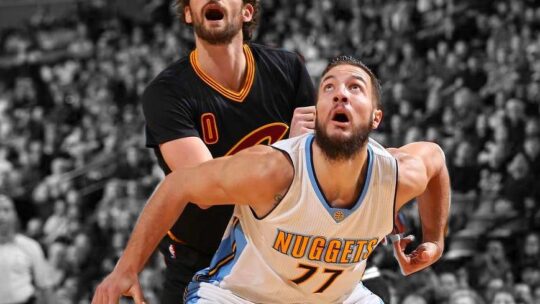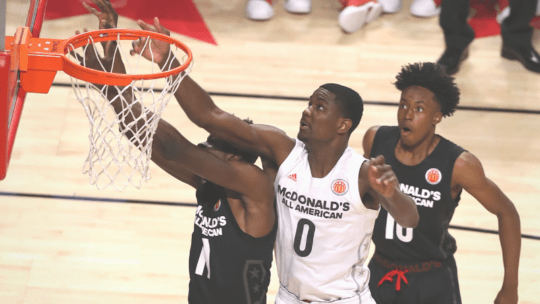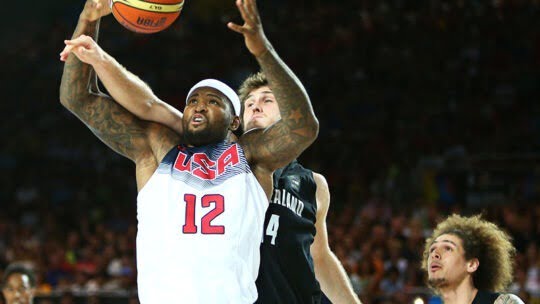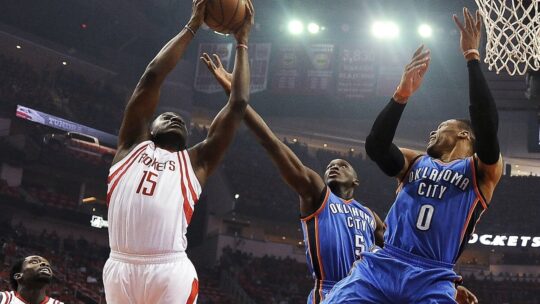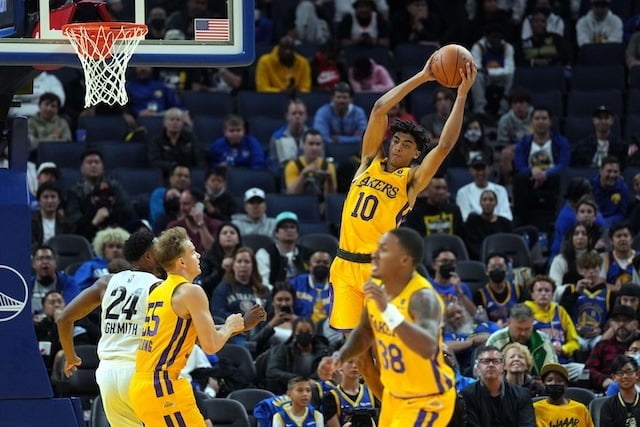Tips To Improve Your Basketball Rebounding Skills
The rebound is a lost art for most kids playing the game today. You will watch many games with kids waiting for the ball to come to them and where they are standing. Rebounding is as much or more work as shooting, posting, or defense.
There is a price to be paid for rebounding that only a few people are willing to pay. You have to be ready to react when a shot is made, be responsible for a player, and then crash hard when the ball is up at the backboard.
It is no easy task, but the team that rebounds the best wins the game – there is no question about that.
Rebounders must be the best people on the floor at reading the game. How players move around and how the ball will react on the backboard or rim. The position is essential, timing is crucial, and it is all part and parcel of reading how the play develops.
Let’s go through some aspects of Basketball rebounding tips that will make you a better player.
-
Boxing out
By far the most crucial element of a successful rebounder, but often the most overlooked. Players wait for rebounds to come to them; they don’t create situations where they can get the rebounds. That is what boxing out is all about — Giving yourself the best opportunity to get the rebound. It’s tough, but it is worth it.
When you box out, you must keep a few things in mind. Your body is your biggest asset. You must use your body to your advantage to be a good rebounder. Proper positioning when you box out can mean between snaring the ball or giving it up to your opponent.
Always be aware of where the opposition players are. Often you aren’t boxing out a player covering you or who you are protecting. You box out the player who has the best chance at rebounding you.
-
Defensive rebound
If you are playing a man-to-man defense, you must always know where your check is. When a shot goes up, you need to find your man. Maneuver your body into a position where your hips and torso are in the way of your opposition. T
hey can’t try and get by you physically, or they will be called for a foul. The person who is appropriately boxed out is helpless.
For a solid box-out position, you should have your feet shoulder-width apart, sink you’re behind a bit, and sit back in your stance. Make your body as solid as possible.
When executing the box out, get the circumference of your body (hips) into the midsection of the defender. You can use your position to drive your opponent from the basket.
When playing zone defense, you are responsible for anyone coming through your zone, including boxing them out when they are there. Sometimes you will get two or more people in your zone at any time, and you need to be able to decide which one of them is the most likely to get the rebound. That is the person you box out.
Here is a good tip when you are boxing out on defense. Create a “no-rebound” zone where you will not let anyone in. Be very conscious of anyone going in and out of that zone, and be prepared to block anyone in your zone when a shot goes up.
Your coach will never get upset at you for boxing anyone out. If you can box people out, you eliminate one possible offensive rebounder from reaching the ball. You also put yourself into a position to get the rebound.
-
Offensive rebound
You still have every right to the ball on offense. You can apply the same principles of the defensive rebound to that of the offensive rebound. Boxing out is essential, but getting your body in front of the defending player may be challenging.
This is where your attention to what is going on in the game will pay huge dividends. On offense, you know where a play is going and where it will end with a shot. You can anticipate when your teammate will shoot the ball, and you can find the position to box out.
Boxing out is equally important on the offensive boards as it is on the defensive side of the ball. You aren’t going to get too many rebounds if you are on the wrong side of the box.
Here are a couple of drills you can use to practice your boxing out:
Grab a partner and start as though you are covering them on defense. Have them take a shot and mentally go through the steps you need to take to get a proper position on them. Find the space to defend and get your body in the way.
Have your partner go half-speed after the rebound, so you can get used to getting position on the play, and then have them go full speed after you start getting more comfortable with making sure you are in the proper place.
You can even switch it up to try and gain an offensive position by having the shooter try and gain position after the shot.
The next drill is more of a team drill but can be done with as few as three players.
If you have an entire team practice, set up five guys in a zone defense. Have three players play the offensive side of the ball. The three offensive players should quickly move the ball around the perimeter, trying to stretch the defense out and give themselves lanes to get offensive rebounds.
The defensive players should move with the ball like in a zone defense. They should be ready to move into a box-out position when one of the offensive players takes a shot.
When the offensive player takes a shot, have them drive to the hoop to get the offensive rebound. The defensive players should have identified the player taking the shot, and they have to squeeze the shooter out of the play by boxing them out.
To make the drill more complicated, have all three offensive players crash the boards instead of just the shooter. It will force the off-side players to ensure their head is in the game by boxing out those who aren’t involved.
Another bonus drill is to see how long you can box each other out if you have just one other player with you. The offensive player must try to get the position, and the defensive player must keep him away from the basket. You do this drill with no ball.
-
Timing your rebound
After you have boxed your opponent out, you must ensure you time your rebound correctly. Nothing is worse than going up for a rebound too soon and having your opponent swipe the ball from over your head because you jumped too early.
But you can’t sit and wait for the ball to come to you because your opponent will grab it before you get your feet out of the cement.
Learning the proper timing is something that comes with experience and practice. You have to be able to read how the ball might react when it hits the backboard or rim; then, you must be ready to spring into action.
You want to get the ball at its highest point after it hits the backboard or rim. A good rule of thumb when timing when to go after a rebound is when it bounces off the edge, reaches the highest point off the bounce, and when you should jump.
If you try and jump for the ball right when it hits the rim when you reach the height of your jump unless you have a 45″ vertical, the ball will be at its highest point, and you will likely miss it. If you wait for it to come down after the ball reaches its apex, you are already too late, and your opponent moves the ball down the court on the fast break.
An excellent rebounding drill to help you with the timing is to take a shot from about 5 or 6′ out, purposely miss the shot, and then step up and try and time your rebound. You will pop up the shot, get into a quick box-out position, and then spring to the rebound. You can do this drill on your own.
Another drill you can do on your own is a common one for players at all levels of basketball.
Stand in front of the backboard, throw the ball up, and continuously jump and rebound the ball back up into the backboard. You can do this one until you are tired. This will help your timing, and it will also help your hands because you have to catch and re-release the ball each time you jump up for the rebound.
-
Going up for the ball
After you have position and time, jump perfectly, go up strong, and right after the ball. Put both hands in the air and grab the ball. It drives coaches crazy to see a player go up and swat at a rebound, thinking they will end up batting it to a player on their side. Just like the rule goes in football – if you can get one hand on it, you can probably get two. Catch the ball in the air and control it for your team.
A good rebounder goes to the hoop with a purpose. Within the rules of physical contact, the rebound specialist fights for position and then boxes out so they can steal rebounds.
When you go up for rebounds, you have to go hard. If you want to be good, you can’t just willy-nilly and hope the rebound comes to you. You have to go and get the rebound.
Improve Your Rebounding skills
-
Develop a Rebounder’s Mindset
We like to think that everyone can be a great rebounder but in reality, that’s not true. Rebounding is hard work and not every player has the required mental toughness. Therefore, the first thing you need to do is to develop a rebounder’s mindset and make rebounding a top priority. Sabi
The great rebounders are a lot like defensive linemen – they relentlessly rush the quarterback every possession even though they will only reach him a relatively few times. You can’t be afraid of contact and must be willing to constantly “get after it.” Hall of Fame coach George Raveling says that outstanding rebounders are “mobile, agile, and hostile.”
Whoever Makes First Contact Wins Check out Better Basketball Player Development videos
With all the new rules and changes coming in it may not always be this way, but for now, basketball is a contact sport and the aggressor usually has a big advantage. Many times the first step in getting more rebounds is to make sure your opponent can’t get to the ball and that means blocking out.
I know many players have been taught to reverse pivot into the offensive rebounder to keep him from getting to the ball. However, in my opinion, the best way to block out is to step toward the offensive player and then execute a front pivot right in front of him.
Using a front pivot allows you to wait for a second longer before making contact which eliminates the offensive strategy of faking one way so the defense will reverse pivot and then go the other way.
-
Keep Your Hands Up
The younger the teams and players the more advantageous it is to be tall. However, height is only an advantage if your hands are constantly above your shoulders. It drives me, and many other coaches, crazy to see a taller player miss out on several rebounds a game simply because his hands are down below his waist.
A rebounder who keeps his hands low will not only get fewer rebounds but will also get more fouls called on him when he blocks out as he will often give the officials the impression that he is holding. Every time the shot goes up get in the habit of putting your “thumbs in your ears” and you’ll be happy with how many more rebounds you’ll grab.
-
Play the Angles
Knowing that most shots that are missed bounce to the weak side and at the same angle that the shot was taken can be a huge advantage if you use it. If you don’t believe me try this experiment – have a teammate shoot jump shots from the wing while you rebound for him.
Stand with your bottom foot just above the big block and see how many rebounds you can get a hand on while standing completely still. Then see how many more you can get by taking just one step in any direction.
Remember that a long shot usually means a longer rebound so adjust your positioning accordingly.
Related Post

